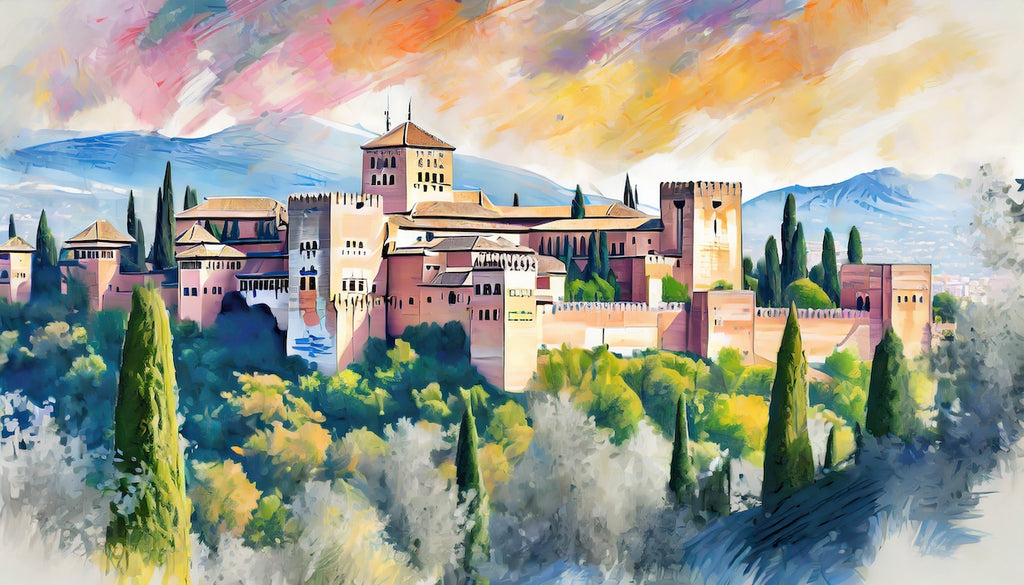 Image/Graphic: Illustration Alhambra Palace, Copyright © squul.com, All rights reserved
Image/Graphic: Illustration Alhambra Palace, Copyright © squul.com, All rights reserved
A Kaleidoscope of Artistry Across Empires
Embark on a vibrant exploration with #SquulOfSultans, a collection that delves into the exquisite artistry of ancient empires of the east such as the Ottoman, Andalusian, Abbasid, Umayyad, and Seljuk empires. Join us as we unravel the intricacies of artistic expressions that adorned the realms of these distinguished sultans, each leaving an indelible mark on the canvas of history.
Ottoman Opulence: Architectural Symphony
The Ottoman Empire, symbolizing the fusion of Eastern and Western influences, is a testament to architectural brilliance. Drawing inspiration from the intricate designs of Ottoman architecture, our collection captures the opulence of their palaces and mosques. Each pattern tells a tale of the Ottoman sultans, their vision, and the cultural synthesis that defined their reign.
Abbasid Splendor: Visionary Caliphs and the House of Wisdom
Enter a great example of the golden age of Islamic civilization under the Abbasid Empire, where visionary caliphs fostered an intellectual renaissance, where science, art, and philosophy thrived in a tapestry of religious and cultural tolerance. Our collection captures the splendor of this era, drawing inspiration from the intricate calligraphy, geometric designs, and vivid colors that graced the House of Wisdom and other cultural centers. Each pattern reflects the Abbasid sultans' patronage of the arts, transforming their empire into a beacon of creativity.
In the Abbasid era, the city of Baghdad became the epicenter of intellectual and cultural brilliance. The Abbasid sultans were known for their patronage of learning, literature, and the arts. The intricate patterns reflect the golden age of Islamic civilization, a testament to the sultans who nurtured a renaissance of knowledge.
Umayyad Elegance: Cordoba's Radiance
During the Umayyad rule, Cordoba exuded an aura of elegance and sophistication. The architectural marvels of the Umayyad sultans, notably the iconic Great Mosque of Cordoba and the intricate geometric patterns gracing palaces, reflected the city's radiant charm. This period invites you to immerse yourself in the timeless elegance of Umayyad artistry, where cultural, historical, and artistic elements converged to create an enduring legacy.
Seljuk Grandeur: Silk Road Marvels
Embark on a journey along the Silk Road to delve into the grandeur of the Seljuk Empire. The essence of Seljuk art and architecture, inspired by the sultans who governed this expansive realm, is a testament to the cultural richness that flourished at the crossroads of the Silk Road. The intricate motifs reflect the masterful craftsmanship of the Seljuk sultans, contributing significantly to the historical, cultural, and artistic tapestry of this dynamic trade route.
Interesting Facts:
-
Ottoman Tulip Mania: During the Tulip Era in the Ottoman Empire, tulips became a symbol of wealth and status, leading to a fascinating period of tulip mania.
-
Andalusian Libraries: The Andalusian sultans were patrons of libraries, amassing vast collections of manuscripts that contributed to the preservation of classical knowledge.
-
Abbasid House of Wisdom: The Abbasid sultans established the House of Wisdom in Baghdad, a center of learning that translated and preserved works from various cultures.
Embrace the #SquulOfSultans: A Fusion of Timeless Legacies
As you explore our #SquulOfSultans collection, immerse yourself in the diverse narratives of these empires and the sultans who shaped their destinies. Each design is a tribute to the grandeur, artistry, and innovation that defined these epochs. Let the #SquulOfSultans frame your space with the elegance of Ottoman, Andalusian, Abbasid, Umayyad, and Seljuk legacies—a fusion of timeless narratives that continue to inspire.
